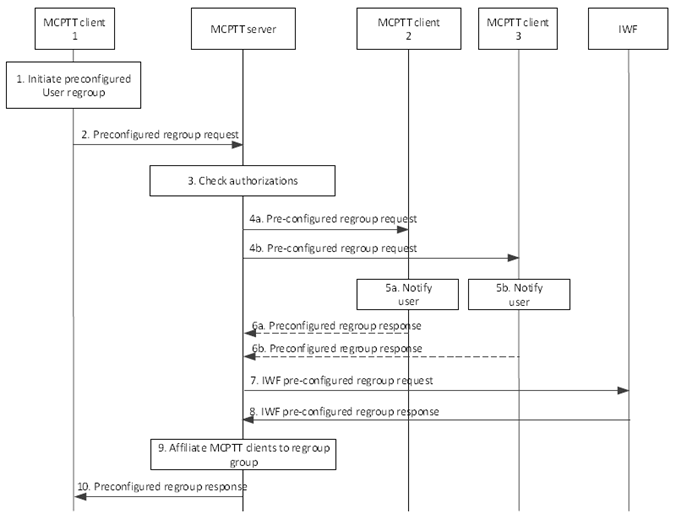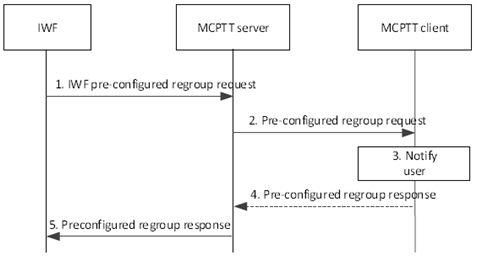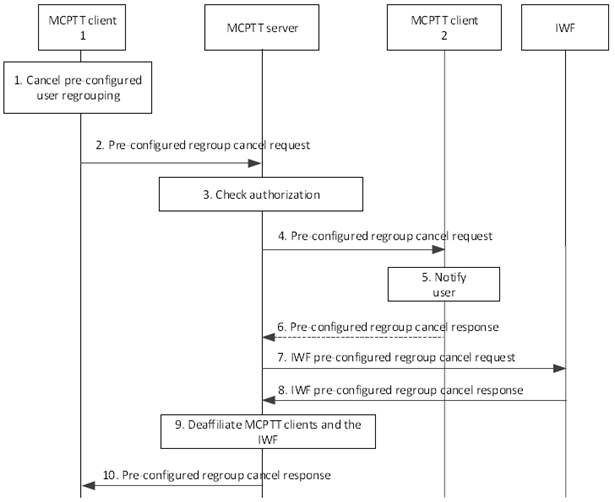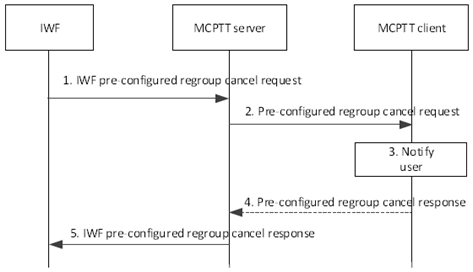Content for TS 23.283 Word version: 19.1.0
1…
10…
10.2…
10.3…
10.3.2
10.3.3…
10.3.4…
10.3.5…
10.3.6…
10.3.7…
10.3.8…
10.4…
10.5…
10.6…
10.6.2…
10.6.3…
10.7…
10.8…
10.11…
10.12…
10.14…
10.15…
10.17…
10.3.8 User regroup with pre-configured group
10.3.8.1 General
10.3.8.2 Pre-configured user regroup formation
10.3.8.3 Pre-configured user regroup cancellation
...
...
10.3.8 User regroup with pre-configured group |R16| p. 84
10.3.8.1 General p. 84
A user regroup may be achieved by regrouping MCPTT users into a new regroup group which uses the configuration of a separate pre-configured MCPTT group. The MCPTT regroup group configuration needs to be provided to the relevant MCPTT users who will be regrouped in advance of the regrouping operation. A pre-configured user regroup may contain users homed in the IWF and the IWF may host pre-configured user regroups which may contain members homed in an MCPTT system.
The pre-configured user regroup that provides the configuration is not used as the pre-configured user regroup itself, it only provides configuration for one or more pre-configured user regroups. The MCPTT group ID of the pre-configured user regroup is provided by the originating authorized user or the originating IWF when the pre-configured user regrouping is carried out.
10.3.8.2 Pre-configured user regroup formation p. 85
10.3.8.2.1 Pre-configured user regroup formation by the MCPTT system p. 85
Figure 10.3.8.2.1-1 illustrates the procedure to initiate a pre-configured user regroup procedure using a pre-configured user regroup. The procedure takes place prior to the establishment of a group call to the pre-configured user regroup.
Pre-conditions:
- MCPTT clients 2 and 3 are registered with the MCPTT service.
- An MCPTT group that will be used for configuration of the pre-configured user regroup has been pre-configured in MCPTT clients 2 and 3 and the IWF, and MCPTT clients 2 and 3 and the IWF have received the relevant security related information to allow them to communicate in the pre-configured user regroup.
- MCPTT client 1 is authorized to initiated a pre-configured user regroup using the pre-configured user regroup procedure.
- MCPTT client 1 is aware of a suitable pre-configured group whose configuration has been pre-configured in the MC service clients of the MCPTT users who will be regrouped.
- The pre-configured user regroup is homed in the MCPTT server.

Step 1.
The authorized user of MCPTT client 1 initiates the pre-configured user regroup procedure, specifying the list of MCPTT users to be regrouped (MCPTT clients 2, 3 and one or more IWF users), the MCPTT group ID of the pre-configured user regroup, and the MCPTT group ID of the group from which configuration information for the pre-configured user regroup is to be taken.
Step 2.
MCPTT client 1 sends the pre-configured regroup request to the MCPTT server. The request indicates the list of users to be included in the regroup operation.
Step 3.
The MCPTT server checks that MCPTT client 1 is authorized to initiate a pre-configured user regroup procedure.
Step 4.
The MCPTT server sends the pre-configured regroup requests to MCPTT clients 2 and 3 in steps 4a and 4b respectively.
Step 5.
MCPTT clients 2 and 3 notify their users of the regrouping in steps 4a and 4b respectively.
Step 6.
MCPTT clients 2 and 3 may send the pre-configured regroup response to the MCPTT server to acknowledge the regrouping action. These acknowledgements are not sent in response to a multicast transmission of the pre-configured regroup request.
Step 7.
The MCPTT server sends the IWF an IWF pre-configured regroup request.
Step 8.
The IWF sends the MCPTT server and IWF pre-configured regroup response.
Step 9.
The MCPTT server affiliates the regrouped MCPTT clients and the IWF to the pre-configured user regroup.
Step 10.
The MCPTT server sends a pre-configured user regroup response to MCPTT client 1.
10.3.8.2.2 Pre-configured user grop regroup formation by the IWF p. 87
Figure 10.3.8.2.2-1 illustrates the procedure for the IWF to initiate a pre-configured user regroup procedure using a pre-configured MCPTT group. The procedure takes place prior to the establishment of a pre-configured user regroup call to the pre-configured user regroup. For simplicity, only one receiving MCPTT client is shown.
Pre-conditions:
- The MCPTT client is registered with the MCPTT service.
- An MCPTT group that will be used for configuration of the pre-configured user regroup has been pre-configured in the MCPTT client and the IWF, and the MCPTT client has received the relevant security related information to allow it to communicate in the pre-configured user regroup.
- The pre-configured user regroup is homed in the IWF.

Step 1.
The IWF initiates the pre-configured user regroup, the IWF sends an IWF pre-configured regroup request to the MCPTT server. The request indicates the list of users to be included in the regroup operation, that are homed in the MCPTT system.
Step 2.
The MCPTT server sends the pre-configured regroup request to the MCPTT client.
Step 3.
The MCPTT client notifies the MCPTT users of the regrouping.
Step 4.
The MCPTT client may send the pre-configured regroup response to the MCPTT server to acknowledge the regrouping action. This acknowledgement is not sent in response to a multicast transmission of the pre-configured regroup request.
Step 5.
The MCPTT server sends an IWF pre-configured regroup response to the IWF.
10.3.8.3 Pre-configured user regroup cancellation p. 88
10.3.8.3.1 Pre-configured user regroup cancellation by the MCPTT system p. 88
Figure 10.3.8.3.1-1 illustrates the procedure to cancel a pre-configured user regroup that uses a pre-configured MCPTT group. For simplicity, only one receiving MCPTT client is shown.
Pre-conditions:
- MCPTT client 2 and at least one user homed in the IWF have been regrouped into the pre-configured user regroup.
- MCPTT client 1 is authorized to cancel a pre-configured user regroup that uses a pre-configured MCPTT group.

Step 1.
The authorized user of MCPTT client 1 initiates the cancellation of the pre-configured user regroup that uses a pre-configured MCPTT group.
Step 2.
MCPTT client 1 sends the pre-configured regroup cancel request to the MCPTT server, specifying the MCPTT group ID of the pre-configured user regroup.
Step 3.
The MCPTT server checks that MCPTT client 1 is authorized to cancel a pre-configured user regroup.
Step 4.
The MCPTT server sends the pre-configured regroup cancel requests to MCPTT client 2.
Step 5.
MCPTT clients 2 notifies the MCPTT user of the cancellation of the pre-configured user regroup.
Step 6.
MCPTT client 2 may send the MCPTT server a pre-configured regroup cancel response. This acknowledgement is not sent in response to a multicast transmission of the pre-configured regroup cancel request.
Step 7.
The MCPTT server sends the IWF an IWF pre-configured regroup cancel request.
Step 8.
The IWF sends the MCPTT server an IWF pre-configured regroup cancel response.
Step 9.
The MCPTT server de-affiliates MCPTT clients 2 and 3 from the pre-configured user regroup.
Step 10.
The MCPTT server sends a pre-configured regroup cancel response to MCPTT client 1.
10.3.8.3.2 Pre-configured user regroup cancellation by the IWF p. 89
Figure 10.3.8.3.2-1 illustrates the procedure to cancel a pre-configured user regroup that uses a pre-configured MCPTT group. For simplicity, only one receiving MCPTT client is shown.
Pre-conditions:
- An MCPTT client and at least one user homed in the IWF have been regrouped into the pre-configured user regroup.

Step 1.
The IWF initiates the cancellation of the pre-configured user regroup. The IWF sends the pre-configured regroup cancel request to the MCPTT server, specifying the MCPTT group ID of the pre-configured user regroup.
Step 2.
The MCPTT server sends the pre-configured regroup cancel requests to the MCPTT client.
Step 3.
The MCPTT client notifies the MCPTT user of the cancellation of the pre-configured user regroup.
Step 4.
The MCPTT client may send the MCPTT server a pre-configured regroup cancel response. This acknowledgement is not sent in response to a multicast transmission of the pre-configured regroup cancel request.
Step 5.
The MCPTT server sends an IWF pre-configured regroup cancel response to the IWF.